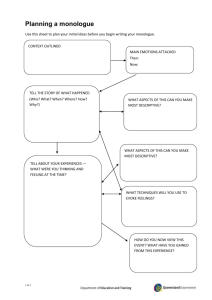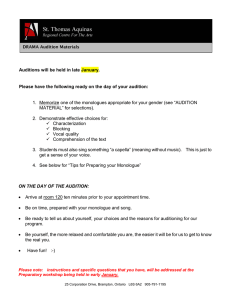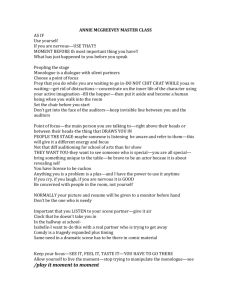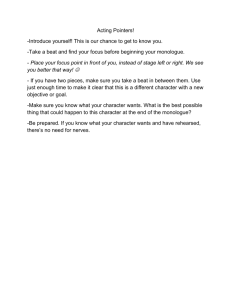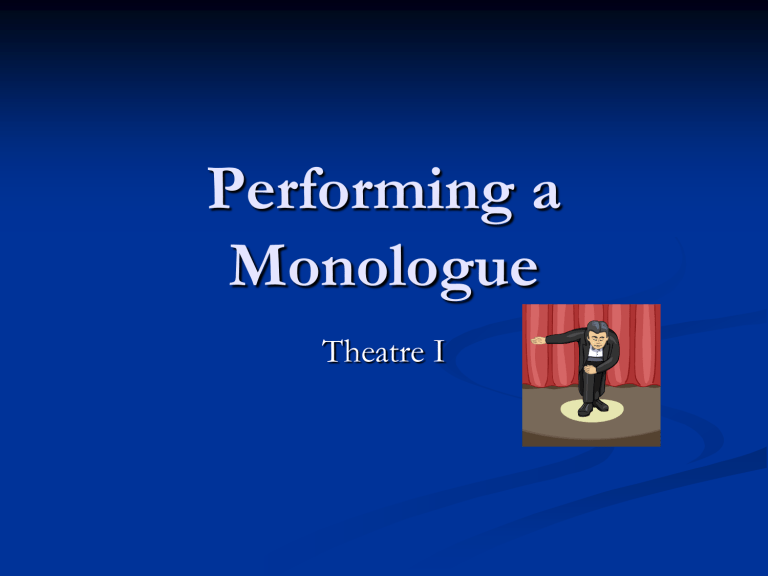
Performing a Monologue Theatre I MONOLOGUES In theatre, a monologue is presented by a single character, most often to express their mental thoughts aloud, though sometimes also to directly address another character or the audience. Monologues are common across the range of dramatic media (plays, films, etc.) as well as in non-dramatic media such as poetry. Monologues share much in common with several other literary devices including soliloquies, apostrophes, and aside. There are, however, distinctions between each of these devices. A Monologue’s Cousins Monologues are similar to soliloquies, epiphanies, and asides. Nevertheless, meaningful differences exist among them. A monologue is distinct soliloquy because the latter involves a character relating his or her thoughts and feelings to him/herself and to the audience without addressing any of the other characters. A monologue is the thoughts of a person spoken out loud. Monologues are also distinct from apostrophes, wherein the speaker or writer addresses an imaginary person, inanimate object, or idea. Asides differ from each of these not only in terms of length (asides being shorter) but also in that asides aren't heard by other characters even in situations where they logically should be (i.e. two characters engaging in a dialogue interrupted by one of them delivering an aside). TYPES OF MONOLOGUES Interior monologues involve a character externalizing their thoughts so that the audience can witness experiences that would otherwise be mostly internal. In contrast, a dramatic monologue involves one character speaking to another character. Monologues can also be divided along the lines of active and narrative monologues. In an active monologue a character is using their speech to achieve a clear goal. Narrative monologues simply involve a character telling a story and can often be identified by the fact that they are in the past tense. Macbeth's monologue Tomorrow and tomorrow and tomorrow after he learns that Lady Macbeth has killed herself: She should have died hereafter; There would have been a time for such a word. Tomorrow, and tomorrow, and tomorrow, Creeps in this petty pace from day to day, To the last syllable of recorded time; And all our yesterdays have lighted fools The way to dusty death. Out, out, brief candle! Life's but a walking shadow, a poor player That struts and frets his hour upon the stage And then is heard no more. It is a tale Told by an idiot, full of sound and fury Signifying nothing. — Macbeth (Act 5, Scene 5, lines 17-28) AUDITION MONOLOGUE Theatre actors may be called upon to use monologues for audition purposes. Audition monologues demonstrate an actor's ability to prepare a piece and deliver a performance. These pieces are usually relegated to two minutes (sometimes less) and are often paired with a contrasting monologue. This can be a comic monologue paired with a dramatic monologue or it can mean classical paired with contemporary. The choice of monologues for an audition can often depend on the play in question or the role the actor wants to land. The audition monologue is a rite of passage with theatre actors and a tradition that continues today. TYPES OF MONOLOGUES Interior monologues involve a character externalizing their thoughts so that the audience can witness experiences that would otherwise be mostly internal. In contrast, a dramatic monologue involves one character speaking to another character. Monologues can also be divided along the lines of active and narrative monologues. In an active monologue a character is using their speech to achieve a clear goal. Narrative monologues simply involve a character telling a story and can often be identified by the fact that they are in the past tense. The monologue performance is one of the most important assignments in a drama class. This assignment involves much more than simply reciting lines in front of the class. You should research the play, to develop a unique character, and to perform with confidence and control. Choosing a Monologue Monologues can be found in many forms: Complete Play: Whether it’s a full length or a one-act, most plays have at least one monologue worth performing. Movie Monologues: Some drama teachers, like me, won’t allow students to select a speech from a film. Monologue Books: There are hundreds of books filled with nothing but monologues. Some are marketed to professional actors, while others cater to high school and middle grade performers. Some books are collections of original, “stand alone” monologues. A "stand alone" monologue is not part of a complete play. It tells its own brief story. Some drama teachers allow them, but some instructors, like me, prefer students to select monologues from published plays so that the performer can learn more about the character’s background. Choose a monologue that is suited to your acting range, age, gender, and appearance. Many actors try to take on a role and character that they clearly could never play, which is not wise. Know what you are auditioning for and choose a monologue based on the genre and possible demands of the role. Pick a piece that will showcase your range and talents. Choosing a Monologue Select one monologue delivered by one character in a play you enjoy and with which you identify. The desired length of the monologue will often be set by the requirements of a given audition, but a good standard length is around 2 minutes. The passage you choose should demonstrate an interesting range of emotion, and should show the character going through some kind of change. What next? Read the entire play containing your monologue, and reflect on it until you have a good grasp of its plot and themes. You will want to thoroughly understand the motivation of the character you will be playing when you perform your monologue. Once you have selected a monologue, read the lines out loud. Make certain you are comfortable with the language, pronunciation, and the definition of each word. Become familiar with the complete play. This can be accomplished by simply reading or watching the play. You can further enhance your understanding by reading a critical analysis and/or a review of the play. Also, learn about the life of the playwright and the historical era in which the play was written. Learning the context of the play will give you insight into your character. Analyze the scene, making a note every time a change--of the character's emotions, intentions, or relationship with another character--occurs. This will allow you to break your monologue down into sections, or beats. Create a Character As tempting as it might be to mimic the performance of your favorite actor, you should strive for originality. No one wants to see a copy of Whoopi Goldberg’s portrayal of Celie in The Color Purple. Find your own voice, your own style. Great characters can be perceived and performed in countless ways. To create a unique interpretation of your subject, study the arc of your character. Analysis Consider answers to some of these: What is your character’s background? How does your character change throughout the play? What is your character’s biggest disappointment? Happiest moment? Deepest fear? So, learn to think, speak, and react the way your character would in a variety of situations. Memorize! Memorize your lines. This is half of the battle. There is a good chance of forgetting your lines because of nerves so know your lines as if they are second nature and be able to say them as though they are words in everyday conversation. Rehearsing Focus not only on portraying the emotions contained in your monologue, but also on transitioning between different beats in a believable manner. Develop your character. The hardest part is making the character you perform 3-dimensionally in those few minutes you have. Things like nervous ticks specific to the character, vocal inflections, the way they would hold themselves and how they would react to a situation (not you) are all necessary to consider when preparing a character. Get Feedback Perform the monologue for a friend or an acting coach. Ask for an honest critique of your work. You will want to make adjustments to your monologue based on the feedback you receive. Rehearse your monologue in front of people that will give you an actual critique instead of just telling you "it was good". Performance Tips Remember that you are being judged from the second you appear on stage to the second you leave it. Always maintain your presence, character, and confidence. Use rehearsal to discover something new If you forget a line do not let it show in your face and do not break character. Try a dramatic pause. Breathe. Skip ahead or improvise something if you need to. But whatever you do, do not panic. Stay focused on your dialogue and mannerisms Take the Stage 1 Dress comfortably. Consider using a minor accessory, such as a piece of jewelry, book or hat to suggest your character without calling attention away from your performance. 2 Position yourself in the center of the spotlight to introduce the piece you will be performing. Let your personality shine through, and be friendly--nobody wants to hire a diva. 3 Block out the audience sitting before you and let yourself truly inhabit the character. Be sure to project your voice so everyone in the space can hear what you're saying. 4 Act as though you are surrounded by the objects and people in your character's world. You may be alone on an empty stage, but you need to imagine it as whatever environment your character is meant to inhabit. If your character is speaking to someone else, track that invisible person with your eyes and act as though that other character has a physical presence. 5 Cap off your monologue with a still moment, holding on your final note before exiting the stage.
